Classification of Vertebrata (Phylum Chordata)

Classification of Vertebrata (Phylum Chordata)
Phylum – Chordata
- Animals belonging to phylum Chordata are fundamentally characterised by the presence of a notochord, a dorsal hollow nerve cord and paired pharyngeal [relating to the pharynx] gill slits.
- They are bilaterally symmetrical, triploblastic, coelomate with organ-system level of organisation.
- Phylum Chordata is divided into three subphyla: Urochordata or Tunicata, Cephalochordata and Vertebrata.
- Subphyla Urochordata and Cephalochordata are often referred to as protochordates and are exclusively marine.
- In Urochordata, notochord is present only in larval tail, while in Cephalochordata, it extends from head to tail region and is persistent throughout their life.
- Examples: Urochordata – Ascidia, Salpa, Doliolum; Cephalochordata – Amphioxus or Lancelet.
| Comparison of Chordates and Non-chordates | ||
| S.No. | Chordates | Non-chordates |
| 1. | Notochord present. | Notochord absent. |
| 2. | Central nervous system is dorsal, hollow and single. | Central nervous system is ventral, solid and double. |
| 3. | Pharynx perforated by gill slits. | Gill slits are absent. |
| 4. | Heart is ventral. | Heart is dorsal (if present). |
| 5. | A post-anal part (tail) is present. | Post-anal tail is absent. |
Vertebrata
- These animals have a true vertebral column and internal skeleton, allowing a completely different distribution of muscle attachment points to be used for movement.
- The members of subphylum Vertebrata possess notochord during the embryonic period.
- The notochord is replaced by a cartilaginous or bony vertebral column in the adult.
- Thus all vertebrates are chordates but all chordates are not vertebrates.
- Besides the basic chordate characters, vertebrates have a ventral muscular heart with two, three or four chambers, kidneys for excretion and osmoregulation and paired appendages which may be fins or limbs.
- Vertibrates are bilaterally symmetrical, triploblastic, coelomic and segmented, with complex differentiation of body tissues and organs.
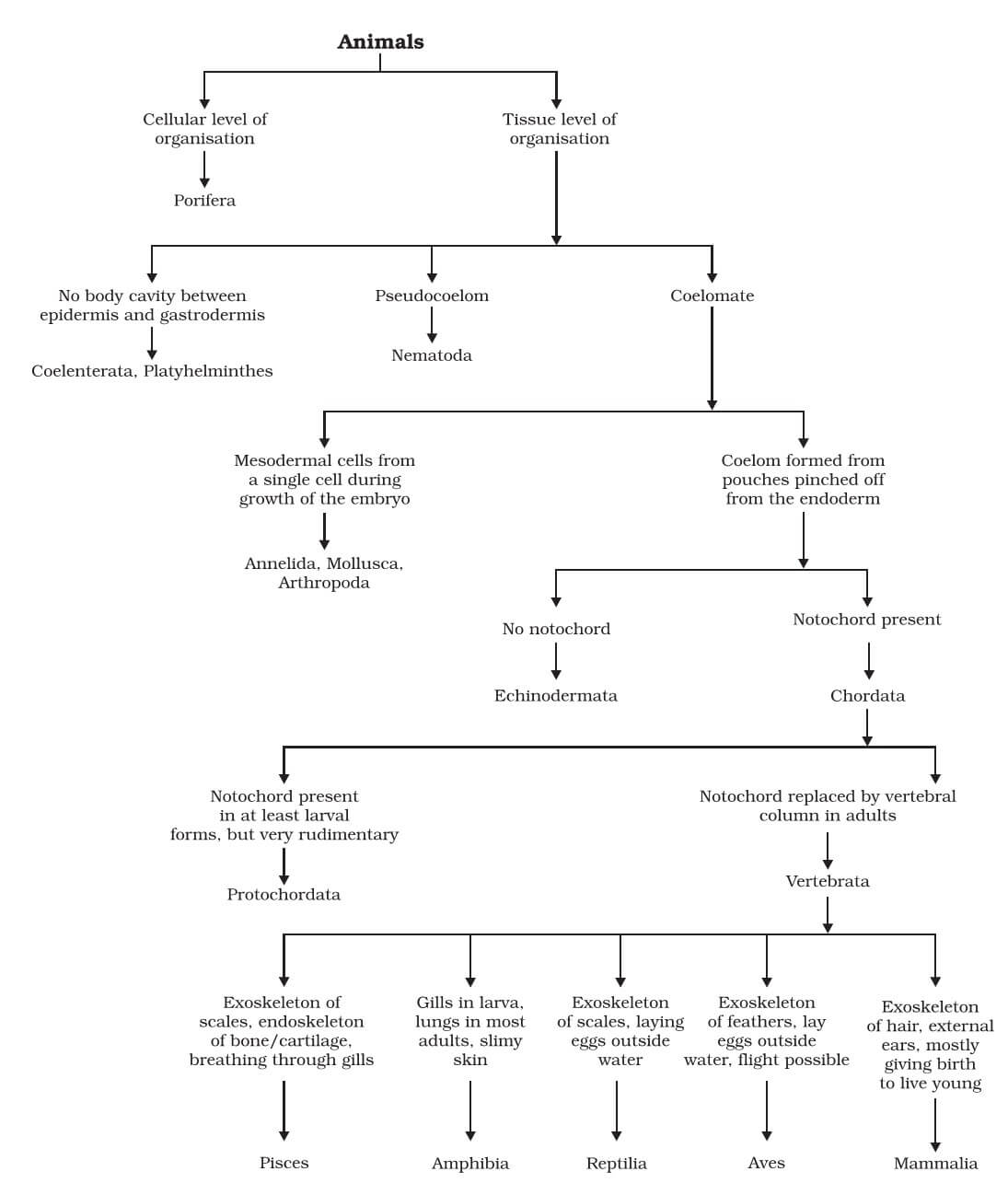
Division In Vertebrata
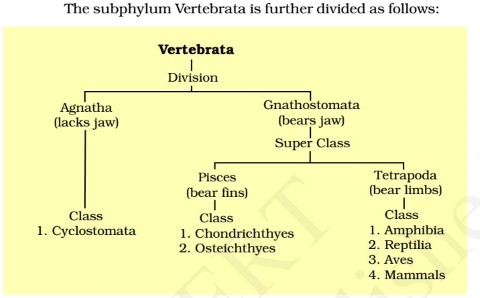
| Basic Concepts
Viviparous and Oviparous Animals
Warm Blooded vs. Cold Blooded Animals
Hibernation
|
Class – Cyclostomata
- All living members of the class Cyclostomata are ectoparasites [ives on the outside of its host] on some fishes.
- They have an elongated body bearing 6-15 pairs of gill slits for respiration.
- Cyclostomes have a sucking and circular mouth without jaws.
- Their body is devoid of scales and paired fins.
- Cranium and vertebral column are cartilaginous.
- Circulation is of closed type.
- Cyclostomes are marine but migrate for spawning [release or deposit eggs] to fresh water.
- After spawning, within a few days, they die. Their larvae, after metamorphosis [transformation from an immature form to an adult form in two or more distinct stages. Example: Larvae → Tadpole → Frog], return to the ocean.
- Examples: Petromyzon (Lamprey) and Myxine (Hagfish).
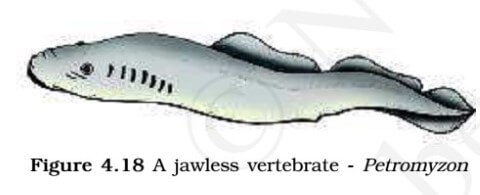
Class – Pisces
- These are fish. Their skin is covered with scales/plates. They lay eggs [oviporous].
- They obtain oxygen dissolved in water by using gills.
- The body is streamlined, and a muscular tail is used for movement.
- They are cold-blooded and their hearts have only two chambers, unlike the four that humans have.
- Some fish skeletons are made entirely of cartilage [Chondrichthyes], such as sharks, and some with a skeleton made of both bone and cartilage [Osteichthyes].

Chondrichthyes
- They are marine animals with streamlined body and have cartilaginous endoskeleton. Mouth is located ventrally.
- Notochord is persistent throughout life.
- Gill slits are separate and without operculum (gill cover).
- The skin is tough, containing minute placoid scales.
- Teeth are modified placoid scales which are backwardly directed.
- Their jaws are very powerful.
- These animals are predaceous [shark].
- Due to the absence of air bladder, they have to swim constantly to avoid sinking.
- Heart is two-chambered (one auricle and one ventricle).
- Some of them have electric organs (e.g., Torpedo) and some possess poison sting (e.g., Trygon).
- They are cold-blooded (poikilothermous) animals, i.e., they lack the capacity to regulate their body temperature.
- Sexes are separate. In males pelvic fins bear claspers.
- They have internal fertilisation and many of them are viviparous [give birth to young ones].
- Examples: Scoliodon (Dog fish), Pristis (Saw fish), Carchaiodon (Great white shark), Trygon (Sting ray).
Osteichthyes
- It includes both marine and fresh water fishes with bony endoskeleton.
- Their body is streamlined. Mouth is mostly terminal.
- They have four pairs of gills which are covered by an operculum on each side.
- Skin is covered with cycloid/ctenoid scales.
- Air bladder is present which regulates buoyancy.
- Heart is two- chambered (one auricle and one ventricle).
- They are cold-blooded
- Sexes are separate.
- Fertilisation is usually external.
- They are mostly oviparous and development is direct.
- Examples: Flying fish, Sea horse, Fighting fish, Angel fish etc.
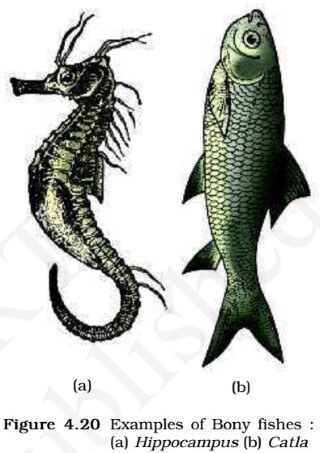
Class – Amphibia
- As the name indicates (Gr., Amphi : dual, bios, life), amphibians can live in aquatic as well as terrestrial habitats.
- The amphibian skin is moist without scales [mucus glands in the skin]. The eyes have eyelids. A tympanum represents the ear.
- Alimentary canal, urinary and reproductive tracts open into a common chamber called cloaca which opens to the exterior.
- They have a three-chambered heart (two auricles and one ventricle). These are cold-blooded
- Respiration is through gills, lungs and through
- Respiration is by gills, lungs and through skin.
- Sexes are separate. Fertilisation is external.
- They are oviparous and development is indirect.
- Examples: Toad, Frog), Tree frog, Salamander, Limbless amphibia.
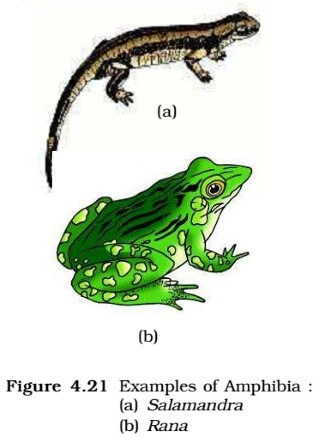
Class – Reptilia
- The class name refers to their creeping or crawling mode of locomotion (Latin, repere or reptum, to creep or crawl).
- They are mostly terrestrial animals and their body is covered by dry and cornified skin, epidermal scales or scutes. Snakes and lizards shed their scales as skin cast.
- They do not have external ear openings. Tympanum represents ear. Limbs, when present, are two pairs.
- Heart is usually three-chambered, but four-chambered in crocodiles.
- Reptiles are poikilotherms [cold-blooded animals].
- They lay eggs with tough coverings and do not need to lay their eggs in water, unlike amphibians.
- Sexes are separate.
- Fertilisation is internal.
- They are oviparous and development is direct.
- Examples: Turtle), Tortoise, Chameleon (Tree lizard), Garden lizard, Crocodile, Alligator, Wall lizard, Poisonous snakes – Naja (Cobra), Bangarus (Krait), Vipera (Viper).
Class – Aves
- They have a four-chambered heart. They breathe through lungs. All birds fall in this category.
- The characteristic features of Aves (birds) are the presence of feathers and most of them can fly except flightless birds (e.g., Ostrich). The forelimbs are modified into wings.
- The hind limbs generally have scales and are modified for walking, swimming or clasping the tree branches.
- Skin is dry without glands except the oil gland at the base of the tail.
- Endoskeleton is fully ossified (bony) and the long bones are hollow with air cavities (pneumatic).
- The digestive tract of birds has additional chambers, the crop and gizzard.
- They are warm-blooded (homoiothermous) animals, i.e., they are able to maintain a constant body temperature.
- Respiration is by lungs. Air sacs connected to lungs supplement respiration.
- Sexes are separate. Fertilisation is internal. They are oviparous and development is direct.
- Examples : Crow, Pigeon, Ostrich), Neophron (Vulture) etc..
Class – Mammalia
- Mammals are warm-blooded animals with four-chambered hearts.
- Most mammals familiar to us produce live young ones. However, a few of them, like the Platypus and the Echidna lay eggs, and some, like kangaroos give birth to very poorly developed young ones.
- They are found in a variety of habitats – polar ice caps, deserts, mountains, forests, grasslands and dark caves. Some of them have adapted to fly or live in water.
- The most unique mammalian characteristic is the presence of milk producing glands (mammary glands) by which the young ones are nourished.
- They have two pairs of limbs, adapted for walking, running, climbing, burrowing, swimming or flying.
- The skin of mammals is unique in possessing hair. External ears or pinnae are present. Different types of teeth are present in the jaw.
- Heart is four-chambered. They are homoiothermous [warm-blooded]. Respiration is by lungs.
- Sexes are separate and fertilisation is internal.
- They are viviparous with few exceptions and development is direct.
- Examples: Oviparous – Platypus; Viviparous – Kangaroo, Flying fox), Delphinus (Common dolphin), Balaenoptera (Blue whale), etc.
Animal Classification Summary
- Porifera includes multicellular animals which exhibit cellular level of organisation and have characteristic flagellated choanocytes.
- The coelenterates have tentacles and bear cnidoblasts. They are mostly aquatic, sessile or free-floating. The ctenophores are marine animals with comb plates.
- The platyhelminths have flat body and exhibit bilateral symmetry. The parasitic forms show distinct suckers and hooks.
- Aschelminthes are pseudocoelomates and include parasitic as well as non-parasitic round worms.
- Annelids are metamerically segmented animals with a true coelom.
- The arthropods are the most abundant group of animals characterised by the presence of jointed appendages.
- The molluscs have a soft body surrounded by an external calcareous shell. The body is covered with external skeleton made of chitin.
- The echinoderms possess a spiny skin. Their most distinctive feature is the presence of water vascular system.
- The hemichordates are a small group of worm-like marine animals. They have a cylindrical body with proboscis, collar and trunk.
- Phylum Chordata includes animals which possess a notochord either throughout or during early embryonic life. Other common features observed in the chordates are the dorsal, hollow nerve cord and paired pharyngeal gill slits.
- Some of the vertebrates do not possess jaws (Agnatha) whereas most of them possess jaws (Gnathostomata). Agnatha is represented by the class, Cyclostomata. They are the most primitive chordates and are ectoparasites on fishes. Gnathostomata has two super classes, Pisces and Tetrapoda.
- Classes Chondrichthyes and Osteichthyes bear fins for locomotion and are grouped under Pisces. The Chondrichthyes are fishes with cartilaginous endoskeleton and are marine.
- Classes, Amphibia, Reptilia, Aves and Mammalia have two pairs of limbs and are thus grouped under Tetrapoda. The amphibians have adapted to live both on land and water.
- Reptiles are characterised by the presence of dry and cornified skin. Limbs are absent in snakes. Fishes, amphibians and reptiles are poikilothermous (coldblooded).
- Aves are warm-blooded animals with feathers on their bodies and forelimbs modified into wings for flying. Hind limbs are adapted for walking, swimming, perching or clasping.
- The unique features of mammals are the presence of mammary glands and hairs on the skin. They commonly exhibit viviparity.